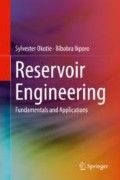Abstract
One of the forces responsible for the primary recovery of hydrocarbon, is the encroachment of a large pool of water body underlying the hydrocarbon accumulation in the reservoir structure. In the evaluation of hydrocarbon reservoir performance, it is paramount to accurately determine the amount of water encroaching into the reservoir whose value is dependent on the water viscosity, the permeability of the rock in the aquifer and the cross-sectional area between the water zone and the region where the hydrocarbon is accumulated. There are several analytical aquifer models presented in the past to estimate the amount of water encroaching into reservoirs, some of which can be applied to linear or radial aquifer, bottom aquifer and/or edge water, finite and/or infinite-acting. Van Everdingen & Hurst method requires the principle of superposition which is a tedious exercise, but it provides an exact solution to the radial diffusivity equation and can be applied at the early stage. The Carter-Tracy aquifer models can be applied to both finite and infinite-acting aquifers, it can be applied to both radial and linear aquifers and also applies to edge-water drive reservoirs only. Fetkovich model applies to both radial and linear aquifers, finite-acting aquifers, edge-water and bottom-water drive reservoirs. Thus, to understand the various aquifer models, several solved example questions and exercises are presented.
Access this chapter
Tax calculation will be finalised at checkout
Purchases are for personal use only
References
Carter RD, Tracy GW (1960) An improved method for calculating water influx. Trans AIME 219:415–417
Fetkovitch MJ (1971) A simplified approach to water influx calculations-finite aquifer systems. J Pet Technol 23:814–828
Schilthuis RJ (1936) Active oil and reservoir energy. Trans AIME 118:37
Van Everdingen, A. F (1953) The skill effect and its influence on the production capacity of a well. Trans. AIME, 198: 171–176
Author information
Authors and Affiliations
Exercises
Exercises
-
1.
What does it imply for a reservoir pressure profile to show a gradual decline?
-
2.
Which of the aquifer model provides an exact solution to the radial diffusivity equation?
-
3.
Which of the aquifer model provides an approximate solution to the radial diffusivity equation?
-
4.
What is the primary difference between Carter-Tracy and Van Everdingen & Hurst Techniques?
-
5.
State the aquifer models that can be applied to both finite and infinite-acting aquifers
-
6.
Which of the aquifer models can be combined with material balance equation?
-
7.
Why is Van Everdingen & Hurst aquifer model difficult to program in computer model?
-
8.
State the aquifer model that can be applied to both radial and linear aquifers and also applies to edge-water drive reservoirs only.
-
9.
Explain the concept of superposition as it applies to water influx model
-
10.
Distinguish between van Everdingen-Hurst and Fetkovich model in terms of transient state flow
-
11.
Which of the aquifer models calculates water influx less than the values predicted by other models?
-
12.
A reservoir whose aquifer is strongly supported by edge water is best fitted with which aquifer model
-
13.
Which of the aquifer model applies to finite-acting aquifers only?
-
14.
State the aquifer model that assumes constant pressure at the original reservoir/aquifer boundary
- Ex 4.1 :
-
Calculate the water influx at the end of 1, 2 & 5 years into a circular reservoir with an aquifer of infinite extent. Effective water permeability and compressibility are 100 mD and 1.0×10−6 psi−1 respectively, reservoir viscosity is 0.84, the radius of the reservoir is 2100 ft, reservoir thickness is 27.5 ft with porosity of 22%. The initial and current reservoir pressure are 2700psig and 2380psig respectively.
- Ex 4.2 :
-
Given the following reservoir and aquifer information with an infinite-acting aquifer:
The pressure history is given as
Time (years) | Pressure (psi) |
|---|---|
0 | 4260 |
1 | 4235 |
1.5 | 4203 |
2 | 4175 |
2.5 | 4115 |
- Ex 4.3 :
-
Using the radial aquifer data provided below, determine the cumulative water influx at each time step, using Hurst van Everdingen and compare result with Fetkovich & Carter-Tracy models.
Time (yrs) | 0 | 1 | 2 | 3 | 4 | 5 |
|---|---|---|---|---|---|---|
Pressure (psia) | 2987 | 2962 | 2927 | 2882 | 2837 | 2793 |
WD(tD) | 0 | 5.7126 | 9.0465 | 11.4326 | 13.1035 | 14.3835 |
Additional Data: Kw = 275 mD, μw = 0.94 cp, h = 56 ft, aquifer radius, ra = 48,000 ft, reservior radius, ro = 14,000 ft, porosity = 22%, encraochment angle of 1200, total compressibility = 7.50 x 10−6 psi−1.
- Ex 4.4 :
-
Calculate the cumulative water influx at each time given in the below of a finite reservoir sustended at encraochment angle of 120° with the following properties Kw = 78 mD, μw = 0.73 cp, h = 128 ft, aquifer radius, ra = 30,000 ft, reservior radius, ro = 6000 ft, porosity = 18%, total compressibility = 7.98 × 10−6 psi−1.
Time (yrs) | 0 | 1 | 2 | 3 | 4 | 5 |
|---|---|---|---|---|---|---|
Pressure (psia) | 2850 | 2610 | 2400 | 2220 | 2070 | 1950 |
Rights and permissions
Copyright information
© 2019 Springer Nature Switzerland AG
About this chapter
Cite this chapter
Okotie, S., Ikporo, B. (2019). Water Influx. In: Reservoir Engineering. Springer, Cham. https://doi.org/10.1007/978-3-030-02393-5_4
Download citation
DOI: https://doi.org/10.1007/978-3-030-02393-5_4
Published:
Publisher Name: Springer, Cham
Print ISBN: 978-3-030-02392-8
Online ISBN: 978-3-030-02393-5
eBook Packages: EnergyEnergy (R0)

